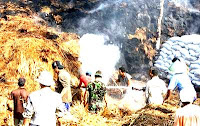loading...
SPONTANEOUS HEATING OF HAY
Okay, on this occasion Ahli Artikel will present an article entitled Spontaneous Heating Of Hay. Please read the article below.
Spontaneous Heating of Hay
Some heating is likely to occur when slightly damp hay is stored in the stack or mow. Micro-organisms, which are able to multiply when the hay is not too dry, consume the material for growth and energy, and release heat and moisture. When this moisture is sufficient to be detectable the hay is said to be going through a sweat. Very dry hay and hay in small piles that allow the heat and moisture to be dissipated are not known to sweat. The moisture released by organisms stimulates further microbiological activity and fermentation, and contributes to increased heating and sweating. Loose hay that contains less than 25 per cent moisture is sufficiently dry at the time of storage to heat or sweat only moderately. Such hay retains its green color and nutritive value. The storage of alfalfa hay of high moisture content causes heavy losses of organic substance, chiefly fats, sugars, and hemicelluloses. The loss in total weigh may be as high as 22 per cent.
Stored wet hay is subject to excessive spontaneous heating. A moisture content somewhat greater than 25 per cent may cause the hay to become brown or black. The green color of hay is destroyed when heating temperatures exceed 122 degrees F. Clean brown hay suitable for feeding is formed at temperatures above 131 degrees F., but below 158 degrees F. The dry-matter losses may be very little in brown hay but they may be heavy when the hay becomes black. In Kansas experiments alfalfa hay stacked with 53 per cent moisture sustained a dry-matter loss of 39 per cent, and a large proportion became black.
Damp hay stored in large masses may develop temperatures sufficiently high to produce ignition. The initial production of heat is due mainly to the action of micro-organism which are capable of raising the temperature of the hay to as high as 158 degrees F., or slightly higher. Temperatures above this (the death point of micro-organisms) probably are the result of fermentation which produces volatile substances. these gaseous substances ay ignite when the temperature rises to 374 degrees F. or higher.
Thus the explanations article about Spontaneous Heating Of Hay.
Hope it is useful. . . .
HAPPY LEARNING . . . . .
SOURCE:
Book Principles of Field Crop Production | John H. Martin - Warren H. Leonard | COLLIER Macmillan (1967)
Okay, on this occasion Ahli Artikel will present an article entitled Spontaneous Heating Of Hay. Please read the article below.
Spontaneous Heating of Hay
Some heating is likely to occur when slightly damp hay is stored in the stack or mow. Micro-organisms, which are able to multiply when the hay is not too dry, consume the material for growth and energy, and release heat and moisture. When this moisture is sufficient to be detectable the hay is said to be going through a sweat. Very dry hay and hay in small piles that allow the heat and moisture to be dissipated are not known to sweat. The moisture released by organisms stimulates further microbiological activity and fermentation, and contributes to increased heating and sweating. Loose hay that contains less than 25 per cent moisture is sufficiently dry at the time of storage to heat or sweat only moderately. Such hay retains its green color and nutritive value. The storage of alfalfa hay of high moisture content causes heavy losses of organic substance, chiefly fats, sugars, and hemicelluloses. The loss in total weigh may be as high as 22 per cent.
Stored wet hay is subject to excessive spontaneous heating. A moisture content somewhat greater than 25 per cent may cause the hay to become brown or black. The green color of hay is destroyed when heating temperatures exceed 122 degrees F. Clean brown hay suitable for feeding is formed at temperatures above 131 degrees F., but below 158 degrees F. The dry-matter losses may be very little in brown hay but they may be heavy when the hay becomes black. In Kansas experiments alfalfa hay stacked with 53 per cent moisture sustained a dry-matter loss of 39 per cent, and a large proportion became black.
Damp hay stored in large masses may develop temperatures sufficiently high to produce ignition. The initial production of heat is due mainly to the action of micro-organism which are capable of raising the temperature of the hay to as high as 158 degrees F., or slightly higher. Temperatures above this (the death point of micro-organisms) probably are the result of fermentation which produces volatile substances. these gaseous substances ay ignite when the temperature rises to 374 degrees F. or higher.
Thus the explanations article about Spontaneous Heating Of Hay.
Hope it is useful. . . .
HAPPY LEARNING . . . . .
SOURCE:
Book Principles of Field Crop Production | John H. Martin - Warren H. Leonard | COLLIER Macmillan (1967)
loading...
